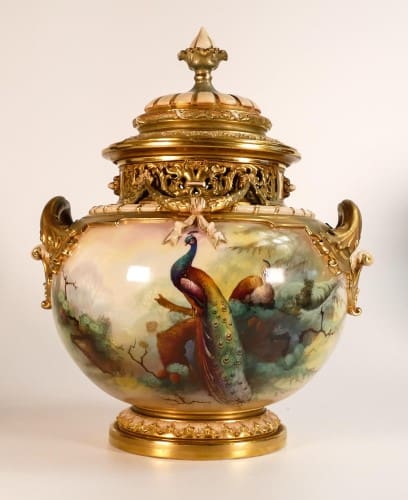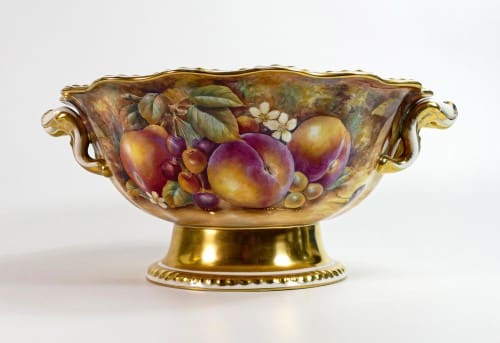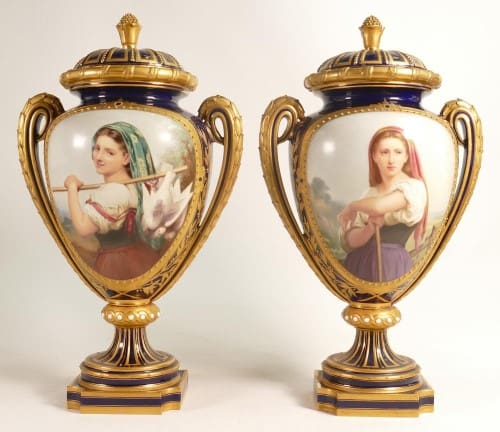Good quality porcelain is often copied, and unfortunately the beautiful work of Royal Worcester is no exception, with plenty of convincing fake pottery pieces on the market. Need help deciding whether you have a fake Royal Worcester piece on your hands? Read on for some handy tips and tricks for how to spot fake Royal Worcester pottery.
First established in 1751, Royal Worcester is thought to be one of the oldest English porcelain brands still in existence today, with their handpainted wares having been synonymous with quality for centuries now. Its early notable success earned the brand a royal warrant in 1788 for the creation of its luxury ceramic tableware and figures. Royal Worcester is also renowned for the array of well-known artists and painters, such as Thomas Baxter and Harry Davis, that have left a mark on the company’s wares over the course of it production, adding to its unique visual appeal and collectability. Today, the Royal Worcester brand can be found under the Portmeirion Pottery Group umbrella, alongside other names such as Spode, Portmeirion and Pimpernel.
Royal Worcester markings are well documented, and most pieces were carefully dated with clear systems to help identify value and age. However, as with many manufacturers, changes in ownership, factory location and differences in artistic design mean there is a vast range of markings and backstamps to look out for, and therefore many markings out there to be faked. Head to our other article for a more comprehensive guide to Royal Worcester markings and backstamps.
As Royal Worcester’s range of inked backstamps are quite easily replicated, this means that fake Worcester backstamps are common, and you can’t rely solely on identifying the markings on your piece alone to determine its authenticity. There are some other telltale signs, however, to help you discern whether your Royal Worcester item may be counterfeit:
- Holding a Royal Worcester piece up to the light will reveals valuable clues in determining whether an item is real. Genuine Worcester soapstone exhibits a distinct greenish hue, for example, while natural daylight will expose any signs of restoration, repairs or concealment efforts to the naked eye.
- Exercise caution with highly decorative pieces, as they are often targeted by forgers. Some resort to skinning pieces – stripping away the original decoration to repaint with more expensive designs – while others use a technique called clobbering. This involves adding a new decoration atop the original and usually just altering the ground colour. Watch for signs of damage or thicker paint layers too, which may indicate tampering.
- Inspect pieces for blemishes and cracks. Authentic Worcester pieces do not feature crackle glaze, as the soapstone used for real Royal Worcester pottery does not craze (a defect of glazed pottery that creates a spider web-like pattern effect).
Fake Royal Worcester pieces often tell on themselves by failing in at least one of the areas above. The late, great Henry Sandon of Antiques Roadshow, who was regarded as the world’s leading expert on Royal Worcester porcelain, put it succinctly when he said in an interview “if it looks anything less than brilliant, I should give it a miss.”
Check out some of the many pieces of genuine Royal Worcester pottery that have passed through our salerooms during some of our recent auctions below. They’re great examples of the beautiful quality Royal Worcester products in circulation that are the real deal!

Lot 973 was a pair of Royal Worcester two handled vases, hand painted with Highland cattle by H Stinton, that sold for an impressive £2,800 at our March 2023 three-day auction.

This Royal Worcester hand painted Pot Pourri vase and cover, painted in fruit still life by S Drysdale, sold at our March 2024 auction for a wonderful £1,300.

Lot 1046 at our November 2023 auction was a large Royal Worcester two-handled pot pourri vase and cover hand painted by A Shuck, selling for very respectable £1,750.

This Royal Worcester large prestige Gadroon Bowl was gilded and hand painted with fruit by D Fuller. It found a hammer price of a whopping £2,700 at our July 2023 three-day auction.

This pair of Royal Worcester vase and covers, dated 1871 and each decorated with farm girls, sold together for an amazing £2,000 at our March 2023 auction.

This Royal Worcester set of coffee cans and saucers, hand painted with fruit by various artists, found a new home for a great £1,300 at our November 2022 auction.
How to sell Royal Worcester pottery at auction
Of course, if you’re still unsure then it’s best to get an expert opinion from an experienced valuer. This is where Potteries Auctions come in. We can identify and provide valuations across a range of Royal Worcester items to help you get the best value at auction for your precious items.
Please get in touch with us if you’re looking for an expert evaluation and are seeking to sell your pottery. Free valuation days are held every Tuesday at our Silverdale saleroom – to book an appointment, use our online booking form here.
Due to popular demand, we have also started to offer a private valuation service for premium items. Please contact us directly to arrange an appointment by emailing amy@potteriesauctions.com.
You can also email us at enquiries@potteriesauctions.com or call us on +44 (0)1782 638100, or valuations can even be provided via WhatsApp – simply send some clear images of your items via the app to 07864 667940.
